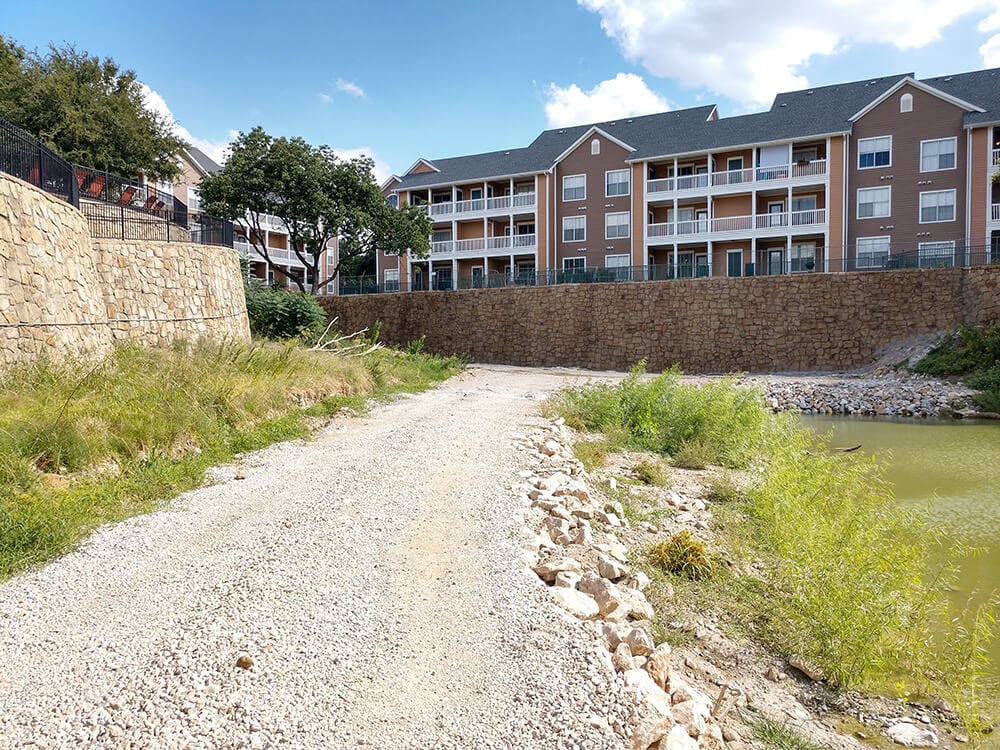





A residential client contacted GeoStabilization International® for assistance with an emergency retaining wall repair. After surveying the site, GeoStabilization’s engineers proposed a solution for repairing the retaining wall by installing a Geosynthetically Confined Soil® (GCS®) wall featuring soil nails and a sculpted shotcrete finish.
The company’s crews replaced approximately 47 linear feet of failed wall with a GCS® wall consisting of 1.5″ x 1.5″ x 10′ galvanized wire baskets on a micropiles foundation system. The client was very content with the final look and continued performance of the new structure.
GCS® structures consist of tightly spaced layers of compacted granular fill and geosynthetic reinforcement sheets. The dense layers create geo-monoliths with extreme load-bearing strengths comparable to those in mining environments – it takes nearly 22,000 pounds per square foot for GCS® pillars to fail. That makes GCS® technology uniquely suited to retainer wall repair projects.
GeoStabilization International® has installed over 1,400 GCS® retaining walls with various applications ranging from rockfall barrier protection systems to bridge abutments. For this residential project, GeoStabilization built a permanent 3,032 square-foot soil nail wall with a maximum height of 20 feet. The crews drilled four-inch diameter holes, through which they threaded the soil nails. Next, they installed:
Finally, the crews applied a two-inch flash coat of shotcrete over the previously constructed GCS® rock basket retaining wall to stabilize the wall face during the soil nail installation and achieve a uniform architectural facing.
A shotcrete facing can often improve the strength of wall retention systems and is one of GeoStabilization’s preferred methods for retaining wall repair.
Shotcrete is concrete applied by spraying the mixture onto the target area using a high-pressure nozzle rather than by casting it in place. Shotcrete can be just as strong, dense, and durable as cast-in-place concrete but is more cost-effective and easier to apply, especially in limited-access areas.
Another advantage to shotcrete is that, while wet, it lends itself well to sculpting and staining to create various architectural or geologic finishes. That allowed GeoStabilization’s technicians to sculpt the facing to match its surroundings and the client’s esthetic requirements perfectly.
GeoStabilization International® has more than twenty years of experience delivering world-class geohazard mitigation and retaining wall solutions to clients in the U.S., Canada, and Australasia.
The company uses innovative equipment and proprietary technologies to deliver rapid installations with minimal infrastructure downtime and business disruption, including in emergency projects and limited-access areas. In addition to saving time, GeoStabilization’s methods often allow clients to realize significant cost savings compared to conventional soil stabilization and slope control methods.
To learn more about the company’s services or request assistance with a retaining wall repair project, call 855-579-0536 or contact GeoStabilization International® today.
If you are interested in a no-obligation site visit to determine if our services fit your geohazard mitigation needs, call us at 855-579-0536 or fill out our contact form.